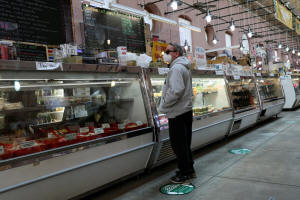U.S. consumer sentiment near 11-year low; near-term inflation worries
mount
 Send a link to a friend
Send a link to a friend
[March 11, 2022] By
Lucia Mutikani
WASHINGTON (Reuters) - U.S. consumer
sentiment fell more than expected in early March as gasoline prices
surged to a record high in the aftermath of Russia's war against
Ukraine, boosting one-year inflation expectations to the highest level
since 1981.
The third straight monthly decline reported by the University of
Michigan on Friday pushed consumer sentiment to its lowest level in
nearly 11 years. It said 24% of respondents "spontaneously mentioned the
Ukraine invasion in response to questions about the economic outlook."
The University of Michigan's preliminary consumer sentiment index
dropped to 59.7 in the first half of this month, the lowest reading
since September 2011, from a final reading of 62.8 in February.
Economists polled by Reuters had forecast the index falling to 61.4.
The survey places more emphasis on gasoline prices and the stock market.
The Conference Board's consumer confidence index, which puts more weight
on the labor market, remains well above its COVID-19 pandemic lows.
Economists said the continued slump in the University of Michigan's
sentiment index was overdone relative to fundamentals and they expected
the economy to continue growing.
The labor market is churning out jobs at a rapid pace, the unemployment
rate is at a two-year low, wages are rising and there were 11.3 million
job openings at the end of January. Consumers have amassed more than $2
trillion in excess savings.
"The relationship between spending and sentiment is loose, particularly
in the short-run, and real disposable income growth and other
determinants of household budgets and finances are more important," said
Scott Hoyt, a senior economist at Moody's Analytics in West Chester,
Pennsylvania.
"Support will also be coming from plentiful jobs and abundant available
cash and credit for many. The volatility of income expectations may
suggest consumers are struggling to understand how labor market
tightness and inflation will impact their budgets."
[to top of second column] |

A man shops at the Eastern Market in Washington, U.S., February 11,
2022. REUTERS/Brendan McDermid
Following Russia's invasion of Ukraine on Feb. 24, crude oil prices jumped more
than 30%, with global benchmark Brent hitting a 2008 high at $139 a barrel,
before retreating to trade around $110 a barrel on Friday.
U.S. gasoline prices are averaging a record $4.331 per gallon compared with
$3.48 a month ago, AAA data showed.
Further increases are likely after President Joe Biden on Tuesday banned imports
of Russian oil into the United States, as part of a wide-ranging tough sanctions
against Moscow.
The University of Michigan survey's gauge of current economic conditions slipped
to a reading of 67.8 from 68.2 in February. Its measure of consumer expectations
declined to 54.4 from 59.4 in February.
The survey's one-year inflation expectations jumped to 5.4%, the highest since
1981, from 4.9% in February. But its five-year inflation expectations held
steady at 3.0% for a second straight month, something likely to be welcomed by
Federal Reserve officials.
The U.S. central bank is expected to start raising interest rates next
Wednesday. Economists expect as many as seven rate hikes this year.
"The stability of the longer-term inflation expectations measure is a slightly
more encouraging sign, providing further tentative evidence that underlying
inflationary pressures are starting to level off," said Andrew Hunter, a senior
economist at Capital Economics.
The government reported on Thursday that consumer prices recorded their largest
annual increase in 40 years in February.
(Reporting by Lucia Mutikani; Editing by Dan Burns and Andrea Ricci)
[© 2022 Thomson Reuters. All rights
reserved.]This material may not be published,
broadcast, rewritten or redistributed.
Thompson Reuters is solely responsible for this content. |